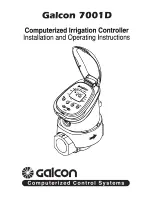
1 8
1 8
1 8
1 8
1 8
GB
GB
GB
GB
GB
Star
Star
Star
Star
Startup
tup
tup
tup
tup
Check the domestic water station and the flushing
water line for correct and proper installation.
The shut-off valves must not be opened yet.
Check the transparent cylinder (3)
(3)
(3)
(3)
(3) to ensure
correct fit and close rotary button for backwas-
hing element (5
5
5
5
5) clockwise.
Slowly open the shut-off valves before and after
the domestic water station and deaerate the piping
at the next tapping point after the domestic water
station.
Open the rotary button (5
5
5
5
5) anticlockwise and after
removing approx. 5 litres close it again. Check the
filter for leaks.
HWS only
HWS only
HWS only
HWS only
HWS only
The pressure reducing valve is factory set to a
back pressure of 4 bar. In order to change the
back pressure, loosen the locking screw (9
9
9
9
9) and
turn the rotary
button for pressure reducing valve (10
10
10
10
10).
The back pressure can be changed by turning
the rotary button (10
10
10
10
10) (control range 2 - 6 bar).
Turning in a clockwise direction = higher back
pressure.
Turning in anticlockwise direction = lower back
pressure.
The indicator for the back pressure setpoint (8
8
8
8
8) is
a standard value. The pressure gauge (6
6
6
6
6) shows
the pressure precisely. During setting, a draw-off
tap after the pressure reducing valve must be
opened briefly several times and closed again.
When water is drawn off, the back pressure drops
temporarily.
The back pressure must not exceed 80% of the
initial pressure of the hot water safety valve
(DIN 1988).
Operation
Operation
Operation
Operation
Operation
Change the back pressure, see Startup.
Backwashing must be carried out once per month
in order to prevent the settling of impurities on the
filter fabric (in case of severe pollution possibly
more often).
Before backwashing, provide a collecting basin,
if the flushing water connection is not connected
to the sewage system.
Backwashing
Backwashing
Backwashing
Backwashing
Backwashing
Turn rotary button (5
5
5
5
5) anticlockwise, until water
flows audibly and then close again. Check the
filter for leaks.
The plastic parts may be cleaned only with a soft,
clamp cloth. Solvents or detergents must not be
used.





































